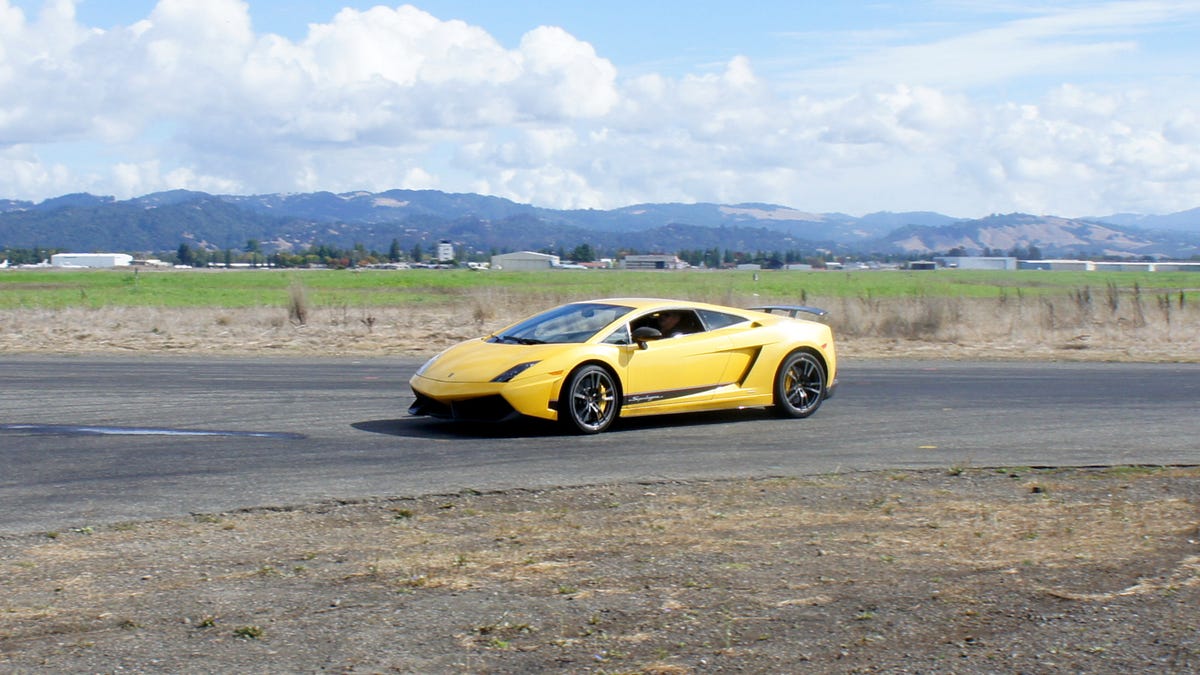Lapping the lightweight Lamborghini
The Lamborghini Gallardo LP 570-4 Superleggera takes advantage of carbon fiber to shed 154 pounds, while getting 10 more horsepower than the standard Gallardo. And we got to run it on a closed course.

At CNET, we dig into the cabin electronics available in just about all new cars, comparing navigation, voice command, and telling you how well your phone will integrate with the hands-free system. But on one chilly Tuesday morning, I put all that aside in favor of some pure automotive adrenaline, getting a feel for the Lamborghini Gallardo LP 570-4 Superleggera.
There is certainly a tech story about the Superleggera. Its 5.2-liter V-10 uses direct injection, and it comes with a six-speed computer-controlled transmission. The car CNET got even had navigation, but it was an older Audi-derived system. But any notion of looking at the cabin tech fell by the wayside when the massive thrust of the V-10 kicked in: a 570-horsepower roar that engendered an immediate grin, part thrill and part terror.
I had driven other fast cars on this relatively small double-figure-8 closed course, but none could quite compare to the Superleggera. Accelerating down the longest straight, approximately 800 feet, I was pretty sure the speedometer brushed past 100 mph. However, it was hard to tell as my eyes were focused on the rapidly approaching bushes up ahead.
The engine lacked the musical growl of a Ferrari, instead sounding off with a high-volume roar accented with throaty bass. That exhaust note is apparently enhanced by the car's Sport mode, which opens baffles to herald its arrival for any interested bystanders. Downshifts with the single-clutch sequential gearbox produced a satisfying, rev-matching burble from the engine.
My laps around the course were hampered by recent rain and rough asphalt, making the quick left- and right-hand turns a serious challenge. But this car's ceramic brakes, a $1,640 option, made losing all that speed acquired on the straight quick and smooth. Any mistakes made were my own fault.
And there was a mistake or two. The Superleggera picked up speed so effortlessly that it was difficult to judge how far to bring it down before the turns. An early attempt at trail-braking showed that this was not a useful tactic for negotiating corners in the all-wheel-drive Lamborghini. It immediately lost a bit of grip and waggled as I worked to get it back under control. Another lazy 180-degree spin was almost a badge of honor.
The sharp turns dictated second gear, while the straights allowed enough room to blip it up to third. The tachometer's 8,500rpm redline allowed a lot of overhead for the lower gears. The steering was excellently sharp, but even with all-wheel drive, the Superleggera required serious caution to avoid a slide.
This type of sequential gearbox came with paddles attached to the steering column, keeping them stationary even with the steering wheel cranked around. With the revs way up, the shifts were satisfying quick, but at lower speeds this gear changes were accompanied with big power drops that made the car buck. On a closed course like we had, the transmission was fine, but I would not want to drive the Superleggera in heavy traffic.
I did most of my laps in Sport mode while shifting manually, but the Superleggera offers a range of driving options. For everyday driving, there is its default, nonsport mode and automatic gear changes. With this combination, the transmission seeks the highest gear and generally stays there. In the curves, I found the default mode's stability and traction control settings made the car very difficult to handle.
Pushing the Sport button on the console dialed down the stability control and also caused the transmission to downshift aggressively when left in automatic mode as I braked before going into a corner. However, taking control of the gears with manual mode was definitely the way to go here.
The Superleggera offers one last mode, activated with a button labeled Corsa. This mode completely turns back stability control further. A few cautious laps with this setup showed the car remained very easy to control, if a little more prone to drift in the corners.
The car certainly makes a distinct fashion statement. Its angular front intakes and body lines seem borrowed from stealth-fighter technology, but the pearl yellow paint color had the opposite effect, making the car stand out clearly from any background we could find.
With its greater power and lessened weight, the Superleggera should technically outperform the base model Gallardo, but could I tell the difference? I doubt the 10-horsepower difference would make itself noticed to my death grip on the wheel as the engine punched the car forward. But 154 pounds is a pretty big weight savings. The Superleggera certainly felt light on its feet, enabling near-effortless control. I think the carbon fiber does make a difference, as long as you have a track where you can let the car run.
The cost of this faster, lighter Gallardo starts at $237,600, almost $50,000 more than the base Gallardo. That is some pricey carbon fiber.

